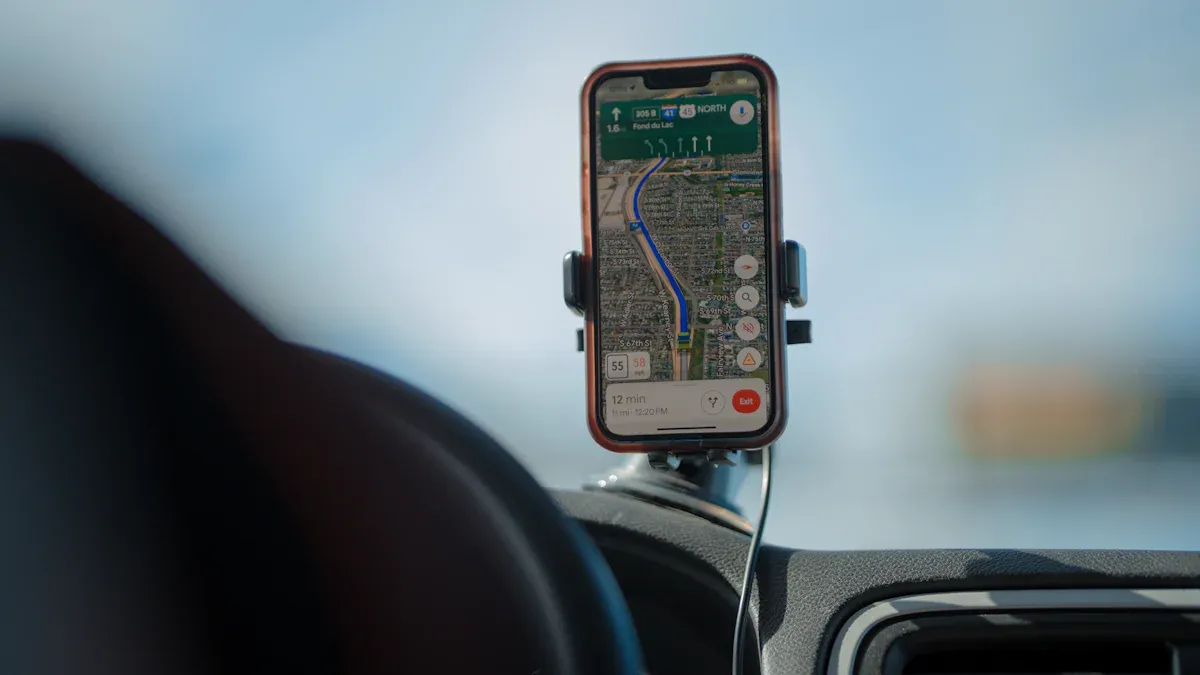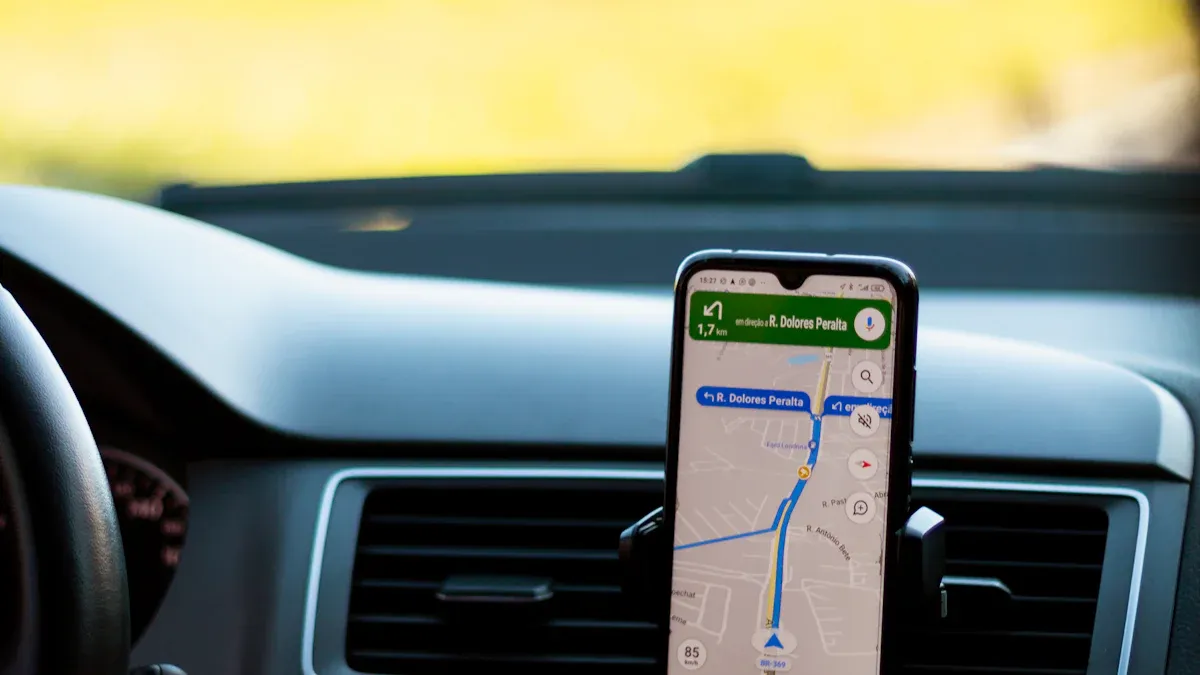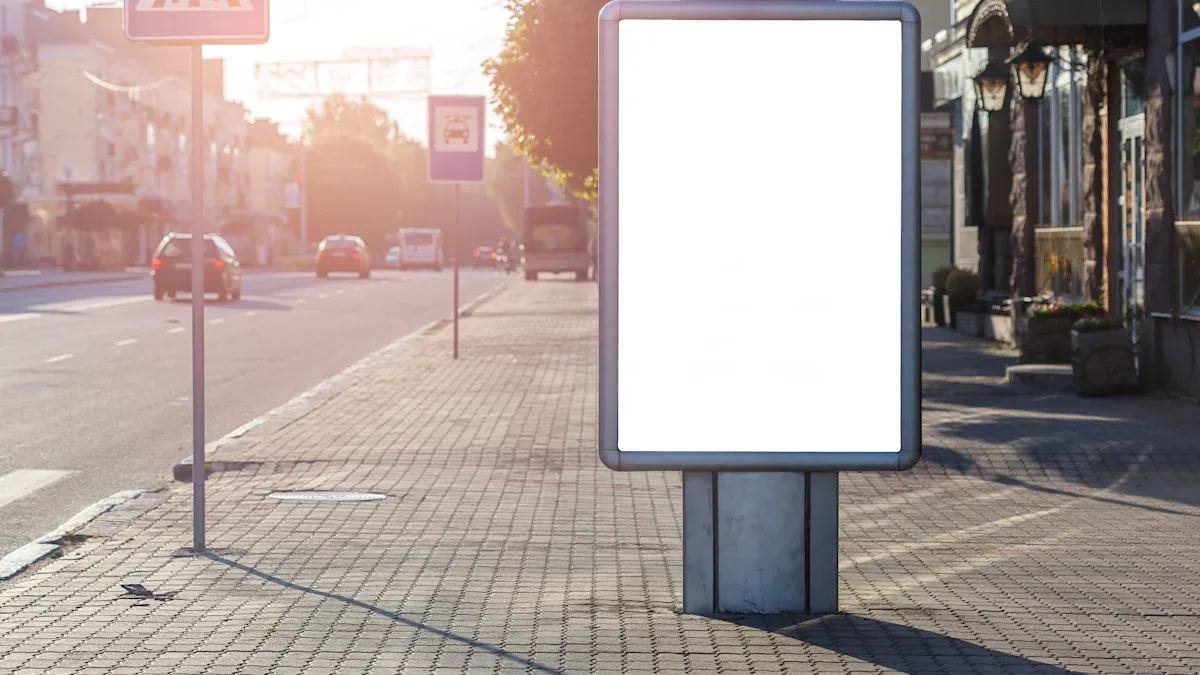
Imagine you drive into a busy shopping center. Suddenly, your car’s screen shows a special deal for your favorite store nearby. This happens because vehicle positioning and geofencing work together to activate ads automatically. When your car enters a set zone, the system activates ads automatically with 5-10 meter accuracy. Accurate data lets marketers send you messages when you are near or inside a store. GPS, Wi-Fi, and mapping systems all work together to make this smooth experience happen.
Key Takeaways
Geofencing makes invisible lines that set off ads when your car goes in or out of a certain area with 5-10 meter accuracy.
Advanced positioning uses GPS, other satellite systems, and sensor fusion to keep your car’s location exact, even in tough places.
Real-time tracking and alerts help send ads at the right time by watching your car’s moves and sending messages right away.
Privacy and security are very important; companies keep your data safe by hiding your identity, following laws, and asking for your permission before using your location for ads.
Vehicle geofencing helps both businesses and customers by sending useful, timely deals while letting you control your data and ad choices.
Vehicle Detection

Geofencing Basics
Geofencing is like drawing invisible lines on a map. These lines make pretend borders around real places, like malls or gas stations. Geofencing uses GPS, RFID, Wi-Fi, or cell data to set up these borders. You can see these borders as circles or shapes on a digital map. When your car with GPS or RFID crosses a border, the system knows right away. This makes things happen, like sending you an ad or a message. Marketers use this to send ads when you enter or leave a place. The system always checks where your car is and works with marketing tools to send messages on time. Fleet managers use geofencing to watch cars and keep them safe.
Positioning Technologies
Many tools help find your car’s spot with good accuracy. Normal GPS receivers show your car’s place within 5-10 meters in open spaces. This is good for most driving needs. Sometimes, you need even better accuracy. Differential GPS uses ground stations to fix mistakes, so your location is even closer. Multi-constellation GNSS receivers use signals from many satellite systems, like GPS, GLONASS, Galileo, and BeiDou. This makes your location more correct and steady. In cities with tall buildings, GPS signals can be weak. So, systems mix GPS with inertial sensors to help. These systems keep your location right, even if signals are lost.
Sensor Fusion
Sensor fusion makes your car’s location data better by mixing info from many sources:
It mixes data from cameras, radar, and LiDAR to lower mistakes from one sensor.
Low-level fusion helps your car see objects in rain, fog, or dark.
The system stops false alarms, so you trust it more.
Sensor fusion helps your car tell objects apart, even far away.
Wheel-speed sensors and accelerometers add more details, especially when GPS is missing.
Sensor fusion helps your car find its spot more exactly, which is important for showing ads at the right time.
How Technology Activates Ads Automatically

Real-Time Tracking
Real-time tracking helps the system show ads at the right time. Your vehicle uses GPS trackers to send its location every few seconds. IoT sensors gather extra data, like your speed or if you stop. Tracking software takes this information and makes it useful. Mobile apps let you see the data right away. Geofencing draws invisible lines on the map, so the system knows when you enter a special area. Real-time notifications tell you or the system when something important happens. The backend, like Redis and PostGIS, handles all the data and saves your location history. This setup helps the system react to your movements quickly.
Here is a table showing the main parts that help with real-time tracking:
Component/Feature | Function/Role | Benefit/Use for Advertising Purposes |
|---|---|---|
GPS Trackers | Give real-time location data of vehicles | Lets live tracking and location-based advertising targeting |
IoT Sensors | Gather vehicle diagnostics and behavior data | Helps vehicle health checks and driver behavior insights |
Tracking Software | Turns sensor data into useful insights | Allows real-time alerts and analytics for dynamic ad placement |
Mobile Apps | Show instant access to tracking data | Makes on-the-go monitoring and campaign changes easier |
Geofencing | Makes virtual boundaries for location triggers | Lets location-based advertising triggers and security |
Real-Time Notifications | Sends instant alerts on events | Helps quick response and adaptive advertising strategies |
Backend Infrastructure | Handles data streams, geospatial queries, and storage | Makes sure data processing and visualization are fast and scalable |
You also use tools like Redis PubSub for event messages, Redis Streams for live data, and PostGIS for map queries. These tools work together to help the system show ads with high accuracy.
Ad Trigger Mechanisms
The system needs a way to know when to show an ad. It uses different triggers to pick the right time. The most common trigger is the entry alert. When your vehicle enters a geofenced zone, the system shows ads automatically. Sometimes, the system uses exit alerts, time alerts, or speed alerts. For example, if you drive into a mall parking lot, the entry alert tells the system to show a special offer. If you leave, an exit alert might remind you about deals you missed.
Here is a table showing different ad trigger mechanisms:
Trigger Mechanism | Description | Use Cases / Benefits |
|---|---|---|
Entry Alert | Happens when a vehicle enters a set geofenced area. | Tracks arrivals, deliveries, job site checks, security. |
Exit Alert | Happens when a vehicle leaves a set geofenced area. | Stops theft, helps fleet management, checks boundaries. |
Time-Based Alert | Happens when a vehicle enters or leaves a geofence at certain times. | Enforces curfews, schedules deliveries, controls activity by time. |
Speed-Based Alert | Happens when a vehicle goes over a speed limit in a geofenced area. | Enforces speed limits in places like schools or work zones. |
Duration-Based Alert | Happens when a vehicle stays inside or outside a geofence too long. | Stops unauthorized stops, checks delivery speed, tracks idling. |
Proximity Alert | Happens when a vehicle gets close to a geofence but does not cross it. | Notifies when near places like service centers or customer spots. |
Journey Alert | Happens if a vehicle leaves or follows a set route in a geofenced area. | Checks delivery routes, school bus paths, service routes for rules. |
Tip: Entry alerts are the most common way the system shows ads when you enter a new area.
Ad Delivery Integration
When the system knows you entered a geofenced zone, it needs to send the ad to you. The backend checks your location and matches it with the right ad. The system uses mapping data, GNSS signals, and V2X communication to check your position. When you cross into the zone, the system shows ads, usually in less than two minutes. Sometimes, if your device has not moved for a while, the delay can be up to six minutes. Most of the time, you see the ad on your car’s screen or your mobile app while you are still there.
For example, you drive into a fast-food parking lot. The system sees your entry using GNSS and mapping data. In about a minute, your dashboard shows a coupon for a free drink. This smooth process happens because the system shows ads as soon as you enter the geofenced zone.
Note: The system can also send ads later, even up to 30 days after you visit a place, but most ads show up right away for the best results.
Accuracy and Reliability
Achieving 5-10m Precision
Location-based ads need to know where you are. Modern vehicles use GNSS receivers to find your spot within 5-10 meters. These receivers get signals from GPS, GLONASS, Galileo, and BeiDou. They work best when you drive in open places. In cities with tall buildings, signals can bounce or get blocked. Your car uses sensor fusion to help with this. It mixes GNSS data with sensors like accelerometers and wheel-speed sensors. This helps your car know its position even if satellite signals are weak.
Tip: Differential GPS and correction services make your location more exact. These tools use ground stations to fix small mistakes in satellite signals.
Your car sends its position every few seconds. This helps the system know when you enter or leave a geofenced zone.
Handling Interference
Interference can make it hard for your car to find its spot. Many things can cause interference. Here are some common sources:
Poorly made communication systems
Broken electronic equipment
Static jamming sources
Continuous wave and narrowband spectral interferences
These problems can affect your car’s GNSS receiver. You might see less accurate positioning in busy places or near airports and ports. The type of GNSS signal and your car’s height can change how much interference you get. Even with tools like pulse blanking and adaptive filters, some interference, like chirp jammers, can still cause problems.
Note: Monitoring systems watch for jamming events to help engineers make things better. Most systems use many ways to lower interference and keep your location data correct.
Privacy and Security
Data Handling
When you drive into a geofenced zone, you share your location. Companies must keep this data safe from others. They use different ways to protect your privacy:
Anonymization: Systems take out details that could show who you are. This helps stop people from knowing the data is yours.
Privacy by Design: Engineers add security from the very start. They look for risks, only collect what is needed, and test safety before using the system.
Legal Protections: Laws like the Driver Privacy Act of 2015 say who can see your vehicle data. Companies must get your permission before using or sharing your info.
Industry Guidelines: Many companies follow privacy rules from industry groups. These rules help keep your data safe during every step.
Companies also use strong codes and check systems often to stop hackers. These steps help keep your personal details safe.
User Consent
You should know how your data is used. Before a company uses your location for ads, you must say yes. In Europe and the UK, laws like the General Data Protection Regulation (GDPR) and the Data Protection Act 2018 say companies must get clear permission. These laws say companies must tell you why they collect your data and how they use it. You must agree before your data is used.
In the United States, most rules are about vehicle safety, not ads. Still, many companies follow good rules. They show you privacy notices and ask for your okay, even if the law does not make them.
You control your data. You can let companies use your location or say no. This helps you feel safe and respected when using smart vehicle technology.
Applications and Benefits
Real-World Use Cases
You can see geofenced ads in many places today. Car dealerships use this to reach you when you visit their lot or a rival’s. You might get a special deal on your phone while shopping for a car. Dealerships set up geofences around their stores to keep you thinking about them. They also reward loyal customers with special offers. At big events like car shows, companies send ads to people who attend. These ads can show up on your phone during the event or after you leave.
Car dealerships target shoppers at their own or rival lots.
Businesses use geofencing to send you deals at competitor locations.
Companies reach out to you at big local events, like car shows.
You get ads on your phone while inside or after leaving a geofenced area.
Marketers track ad views, calls, website visits, and store visits to see what works.
Since 71% of car shoppers use mobile devices, geofencing helps companies connect with you at the right time.
Geofencing lets businesses send ads that match where you are and what you like, making messages more helpful and on time.
Business and Consumer Value
Businesses get many good things from vehicle geofencing. They can send ads to exact places, like rival dealerships or billboards you drive by. This helps them save money and reach you when you might act. Companies track how many people see their ads, visit their website, or come to their store. This helps them know what works and make better ads next time. Real-time data lets them change ads fast for better results.
You also get something from these ads. When you get offers that fit your location and needs, they feel more useful. Ads sent while you are near a store or event seem timely and can make you use more coupons. But sometimes, these ads can feel too personal or even annoying, especially if they use very exact location data. Businesses need to balance making ads personal and respecting your privacy.
Aspect of Consumer Perception | Evidence Summary |
|---|---|
You find ads more helpful when they match your location and interests. | |
Intrusiveness and Privacy Concerns | Very targeted ads can feel too personal if they use exact location data. |
Psychological Reactance | You may not like ads if you feel your choices are limited. |
Effectiveness Factors | Ads work best when they are timely, personal, and fit your needs. |
Overall Consumer Value Perception | You like ads that fit your life but want privacy and control. |
Vehicle geofencing helps businesses get more attention and better results, while you get more useful offers—if your privacy is protected.
You can see how vehicle technology shows ads by itself when you drive into a certain place. This works because the system uses live data, geofencing, and smart sensors to send you the right ad. Companies can aim their ads better and make more money, while you get deals that fit you. In the future, AI and new things like VR and AR will make ads feel even more special and fun. Privacy laws will decide how companies use your data, so you can keep control.
Future Trends | Impact on Advertising |
|---|---|
Smarter, adaptive ad delivery | |
VR/AR Integration | More engaging experiences |
Stronger Privacy Laws | Greater user trust |
FAQ
How does my car know when I enter a geofenced area?
Your car uses GPS and sensors to find where you are. When you drive into a geofenced zone, the system notices right away. This starts the ad process by itself.
Can I turn off location-based ads in my vehicle?
Yes, you can turn off these ads in your car’s settings or app. Check for privacy or location choices. You get to decide if you want these messages.
Will these ads use my personal information?
Most systems use data that does not show who you are. They do not keep your name or contact info. Companies follow privacy rules and ask before using your location.
What happens if GPS signals are weak or lost?
Your car uses other sensors, like accelerometers and wheel-speed sensors, to keep tracking you. This helps the system stay correct, even in tunnels or near tall buildings.
See Also
Best Wireless Android Auto Devices For Audi Vehicles 2025
Comparing The Leading Wireless Android Auto Adapters 2025
Key Developments Influencing Wireless Android Auto Adapters
